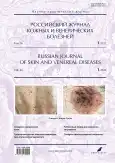Disease burden and physical activity in patients with chronic spontaneous urticaria
- Authors: Popova C.Y.1, Zaborova V.A.1, Kurshev V.V.1, Kovalkova E.V.2, Serdoteckova S.A.2, Fomina D.S.1,2, Borzova E.Y.1
-
Affiliations:
- The First Sechenov Moscow State Medical University (Sechenov University)
- City Hospital No. 52, Moscow
- Issue: Vol 26, No 1 (2023)
- Pages: 63-71
- Section: DERMATOLOGY
- URL: https://journals.rcsi.science/1560-9588/article/view/132595
- DOI: https://doi.org/10.17816/dv139220
- ID: 132595
Cite item
Abstract
BACKGROUND: Сhronic spontaneous urticaria is a disease characterized by itchy wheals and/or angioedema on the skin over a period of 6 weeks or longer. Сhronic spontaneous urticaria is characterized by a significant disease burden for patients, their families, healthcare system and a society. Some aspects of сhronic spontaneous urticaria burden. Including the disease impact on physical activity and sport engagement, have not been well characterized.
AIM: to evaluate the сhronic spontaneous urticaria impact on patient’s quality of life and physical activity of patients, and to assess the correlation between the level of physical activity and a UCT control/severity.
MATERIALS AND METHODS: The study included 31 сhronic spontaneous urticaria patients, who underwent history taking and a survey using international questionnaires: UAS7 (Urticaria Activity Score for 7 days), UCT (Urticaria Control Test), DLQI (Dermatology Life Quality Index) и GPAQ (Global Physical Activity Questionnaire) developed by the World Health Organization (WHO).
RESULTS: According to the GPAQ results, the physical activity level below that recommended by WHO was noted in five (16.1%) patients (MET-minutes/week ≤600). The moderate level of physical activity was reported in 17 (54.8%) patients, and the high level ― 9 (29%). Median sedentary time in сhronic spontaneous urticaria patients was 420 [300–480] min/day, that exceeds the WHO recommendations. The DLQI assessment suggests that 16 (51.6%) сhronic spontaneous urticaria patients had difficulties in their sport activities. Four (12.9%) patients had very strong impact of сhronic spontaneous urticaria on their sport activities. Noteworthy, five patients had to stop their regular physical activity because of сhronic spontaneous urticaria severity. Based on the UCT data, uncontrolled сhronic spontaneous urticaria was reported in 23 of 31 (74.2%) patients, who also had a significantly lower quality of life compared to those with a well-controlled disease.
CONCLUSIONS: Сhronic spontaneous urticaria may negatively affect patient’s quality of life, including their physical activity. A sedentary lifestyle (below the WHO recommendations) was noted in 16.1% patients. In further studies, the optimized recommendations for physical activity in сhronic spontaneous urticaria patients should consider their disease control/severity, their fitness level and patient’s preferences.
Full Text
##article.viewOnOriginalSite##About the authors
Christina Y. Popova
The First Sechenov Moscow State Medical University (Sechenov University)
Email: popova.derm@gmail.com
ORCID iD: 0000-0002-7855-6207
SPIN-code: 5794-9317
Postgraduate Student
Russian Federation, MoscowViktoriya A. Zaborova
The First Sechenov Moscow State Medical University (Sechenov University)
Email: vaz111v@gmail.com
ORCID iD: 0000-0001-5044-1152
SPIN-code: 5969-8486
MD, Dr. Sci. (Med.), Professor
Russian Federation, MoscowVladislav V. Kurshev
The First Sechenov Moscow State Medical University (Sechenov University)
Email: kurshev.vlad@gmail.com
ORCID iD: 0000-0002-1729-0513
SPIN-code: 2766-3925
MD, Cand. Sci. (Med.), Assistant
Russian Federation, MoscowElena V. Kovalkova
City Hospital No. 52, Moscow
Email: ev-kovalkova@yandex.ru
ORCID iD: 0000-0002-1212-3767
SPIN-code: 3078-0976
Russian Federation, Moscow
Sofya A. Serdoteckova
City Hospital No. 52, Moscow
Email: darklynx813@gmail.com
ORCID iD: 0000-0001-8472-1152
SPIN-code: 6644-6715
Russian Federation, Moscow
Daria S. Fomina
The First Sechenov Moscow State Medical University (Sechenov University); City Hospital No. 52, Moscow
Email: daria_fomina@mail.ru
ORCID iD: 0000-0002-5083-6637
SPIN-code: 3023-4538
MD, Dr. Sci. (Med.), Associate Professor
Russian Federation, Moscow; MoscowElena Y. Borzova
The First Sechenov Moscow State Medical University (Sechenov University)
Author for correspondence.
Email: eborzova@gmail.com
ORCID iD: 0000-0003-1587-9137
SPIN-code: 4779-7664
MD, Dr. Sci. (Med.), Professor
Russian Federation, MoscowReferences
- Zuberbier T, Latiff AH, Abuzakouk M, et al. The international EAACI/GA²LEN/EuroGuiDerm/APAAACI guideline for the definition, classification, diagnosis, and management of urticaria. Allergy. 2022;77(3):734–766. doi: 10.1111/all.15090
- Allergology. Federal Clinical Guidelines. Ed. by R.M. Khaitov, N.I. Ilyina. Moscow: Pharmarus Print Media; 2014. 126 p. (In Russ).
- Moestrup K, Ghazanfar MN, Thomsen SF. Patient-reported outcomes (PROs) in chronic urticaria. Int J Dermatol. 2017;56(12):1342–1348. doi: 10.1111/ijd.13668
- Maurer M, Weller K, Bindslev-Jensen C, et al. Unmet clinical needs in chronic spontaneous urticaria. A GA²LEN task force report. Allergy. 2011;66(3):317–330. doi: 10.1111/j.1398-9995.2010.02496.x
- Gonçalo M, Gimenéz-Arnau A, Al-Ahmad M, et al. The global burden of chronic urticaria for the patient and society. Br J Dermatol. 2021;184(2):226–236. doi: 10.1111/bjd.19561
- Zuberbier T, Aberer W, Asero R, et al. The EAACI/GA(2)LEN/EDF/WAO Guideline for the definition, classification, diagnosis, and management of urticaria: The 2013 revision and update. Allergy. 2014;69(7):868–887. doi: 10.1111/all.12313
- Weldon DR. Quality of life in patients with urticaria. Allergy Asthma Proc. 2006;27(2):96–99.
- O’Donnell BF, Lawlor F, Simpson J, et al. The impact of chronic urticaria on the quality of life. Br J Dermatol. 1997;136(2):197–201.
- Maurer M, Abuzakouk M, Bérard F, et al. The burden of chronic spontaneous urticaria is substantial: Real-world evidence from ASSURE-CSU. Allergy. 2017;72(12):2005–2016. doi: 10.1111/all.13209
- Danilycheva I, Emelyanov A, Meshkova R, et al. Treating chronic urticaria refractory to H1-antihistamines in Russia: Data from the AWARE study. Postepy Dermatol Alergol. 2022;39(3):509–516. doi: 10.5114/ada.2022.117556
- Nettis E, Pannofino A, D’Aprile C, et al. Clinical and aetiological aspects in urticaria and angioedema. Br J Dermatol. 2003;148(3):501–506. doi: 10.1046/j.1365-2133.2003.05169.x
- Auker L, Cordingley L, Pye SR, et al. What are the barriers to physical activity in patients with chronic plaque psoriasis? Br J Dermatol. 2020;183(6):1094–1102. doi: 10.1111/bjd.18979
- Safdar A, Tarnopolsky MA. Exosomes as mediators of the systemic adaptations to endurance exercise. Cold Spring Harb Perspect Med. 2018;18(3):a029827. doi: 10.1101/cshperspect.a029827
- Petersen AM, Pedersen BK. The anti-inflammatory effect of exercise. J Appl Physiol. 2005;98(4):1154–1162. doi: 10.1152/japplphysiol.00164.2004
- Niemelä M, Kangastupa P, Niemelä O, et al. Acute changes in inflammatory biomarker levels in recreational runners participating in a marathon or half-marathon. Sports Med Open. 2016;2(1):21. doi: 10.1186/s40798-016-0045-0
Supplementary files








